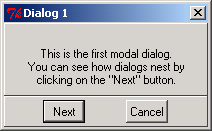Modal dialog nesting demonstration

#Pmw copyright
#Copyright 1997-1999 Telstra Corporation Limited, Australia
#Copyright 2000-2002 Really Good Software Pty Ltd, Australia
#Permission is hereby granted, free of charge, to any person obtaining a copy
#of this software and associated documentation files (the "Software"), to deal
#in the Software without restriction, including without limitation the rights
#to use, copy, modify, merge, publish, distribute, sublicense, and/or sell
#copies of the Software, and to permit persons to whom the Software is furnished
#to do so, subject to the following conditions:
#The above copyright notice and this permission notice shall be included in all
#copies or substantial portions of the Software.
#THE SOFTWARE IS PROVIDED "AS IS", WITHOUT WARRANTY OF ANY KIND, EXPRESS OR IMPLIED,
#INCLUDING BUT NOT LIMITED TO THE WARRANTIES OF MERCHANTABILITY, FITNESS FOR A
#PARTICULAR PURPOSE AND NONINFRINGEMENT. IN NO EVENT SHALL THE AUTHORS OR COPYRIGHT
#HOLDERS BE LIABLE FOR ANY CLAIM, DAMAGES OR OTHER LIABILITY, WHETHER IN AN ACTION
#OF CONTRACT, TORT OR OTHERWISE, ARISING FROM, OUT OF OR IN CONNECTION WITH THE
#SOFTWARE OR THE USE OR OTHER DEALINGS IN THE SOFTWARE.
title = 'Modal dialog nesting demonstration'
# Import Pmw from this directory tree.
import sys
sys.path[:0] = ['../../..']
import Tkinter
import Pmw
class Demo:
def __init__(self, parent):
# Create button to launch the dialog.
w = Tkinter.Button(parent, text = 'Show first dialog',
command = self.showFirstDialog)
w.pack(padx = 8, pady = 8)
self.timerId = None
self.dialog1 = Pmw.MessageDialog(parent,
message_text = 'This is the first modal dialog.\n' +
'You can see how dialogs nest by\n' +
'clicking on the "Next" button.',
title = 'Dialog 1',
buttons = ('Next', 'Cancel'),
defaultbutton = 'Next',
command = self.next_dialog)
self.dialog1.withdraw()
self.dialog2 = Pmw.Dialog(self.dialog1.interior(),
title = 'Dialog 2',
buttons = ('Cancel',),
deactivatecommand = self.cancelTimer,
defaultbutton = 'Cancel')
self.dialog2.withdraw()
w = Tkinter.Label(self.dialog2.interior(),
text = 'This is the second modal dialog.\n' +
'It will automatically disappear shortly')
w.pack(padx = 10, pady = 10)
def showFirstDialog(self):
self.dialog1.activate()
def cancelTimer(self):
if self.timerId is not None:
self.dialog2.after_cancel(self.timerId)
self.timerId = None
def deactivateSecond(self):
self.timerId = None
self.dialog2.deactivate()
def next_dialog(self, result):
if result != 'Next':
self.dialog1.deactivate()
return
self.timerId = self.dialog2.after(3000, self.deactivateSecond)
self.dialog2.activate()
######################################################################
# Create demo in root window for testing.
if __name__ == '__main__':
root = Tkinter.Tk()
Pmw.initialise(root)
root.title(title)
exitButton = Tkinter.Button(root, text = 'Exit', command = root.destroy)
exitButton.pack(side = 'bottom')
widget = Demo(root)
root.mainloop()
Related examples in the same category